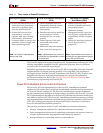
PowerPC™ 405 Processor Block Reference Guide www.xilinx.com 19
UG018 (v2.0) August 20, 2004 1-800-255-7778
R
x Special-purpose registers for controlling the use of debug resources, timer resources,
interrupts, real-mode storage attributes, memory-management facilities, and other
architected processor resources.
x A device-control-register address space for managing on-chip peripherals such as
memory controllers.
x A dual-level interrupt structure and interrupt-control instructions.
x Multiple timer resources.
x Debug resources that enable hardware-debug and software-debug functions such as
instruction breakpoints, data breakpoints, and program single-stepping.
Virtual Environment
The virtual environment defines architectural features that enable application programs to
create or modify code, to manage storage coherency, and to optimize memory-access
performance. It defines the cache and memory models, the timekeeping resources from a
user perspective, and resources that are accessible in user mode but are primarily used by
system-library routines. The following summarizes the virtual-environment features of the
PowerPC embedded-environment architecture:
x Storage model:
i Storage-control instructions as defined in the PowerPC virtual-environment
architecture. These instructions are used to manage instruction caches and data
caches, and for synchronizing and ordering instruction execution.
i Storage attributes for controlling memory-system behavior. These are: write-
through, cacheability, memory coherence (optional), guarded, and endian.
i Operand-placement requirements and their effect on performance.
x The time-base function as defined by the PowerPC virtual-environment architecture,
for user-mode read access to the 64-bit time base.
Operating Environment
The operating environment describes features of the architecture that enable operating
systems to allocate and manage storage, to handle errors encountered by application
programs, to support I/O devices, and to provide operating-system services. It specifies
the resources and mechanisms that require privileged access, including the memory-
protection and address-translation mechanisms, the exception-handling model, and
privileged timer resources. Table 1-2 summarizes the operating-environment features of
the PowerPC embedded-environment architecture.


















